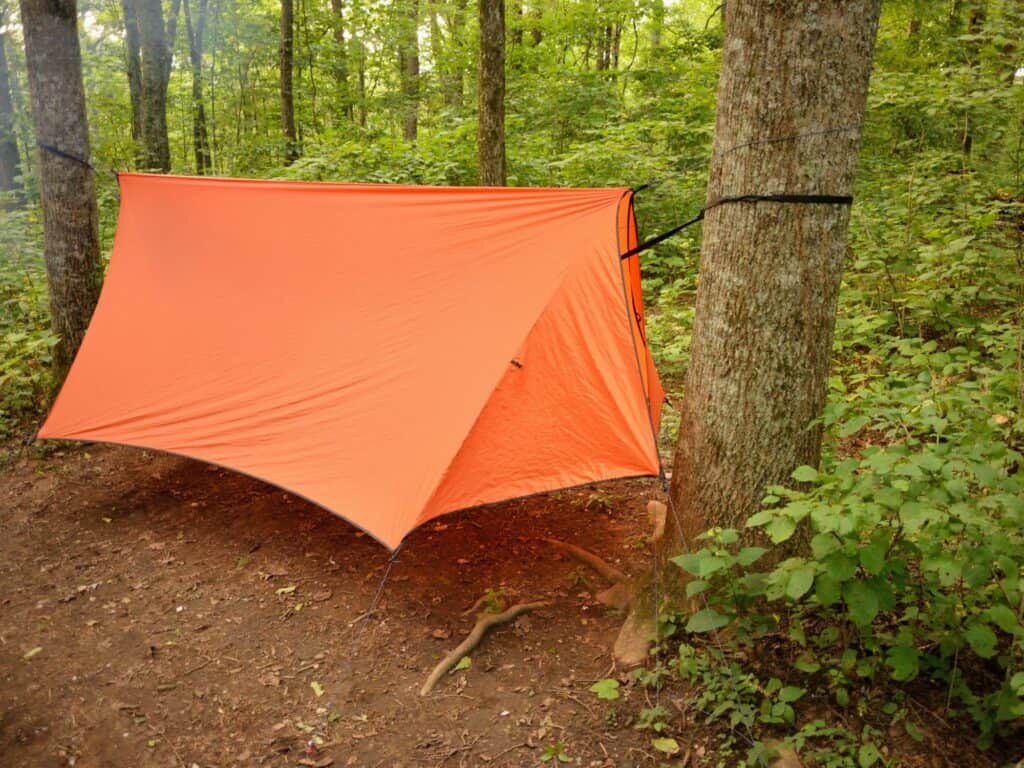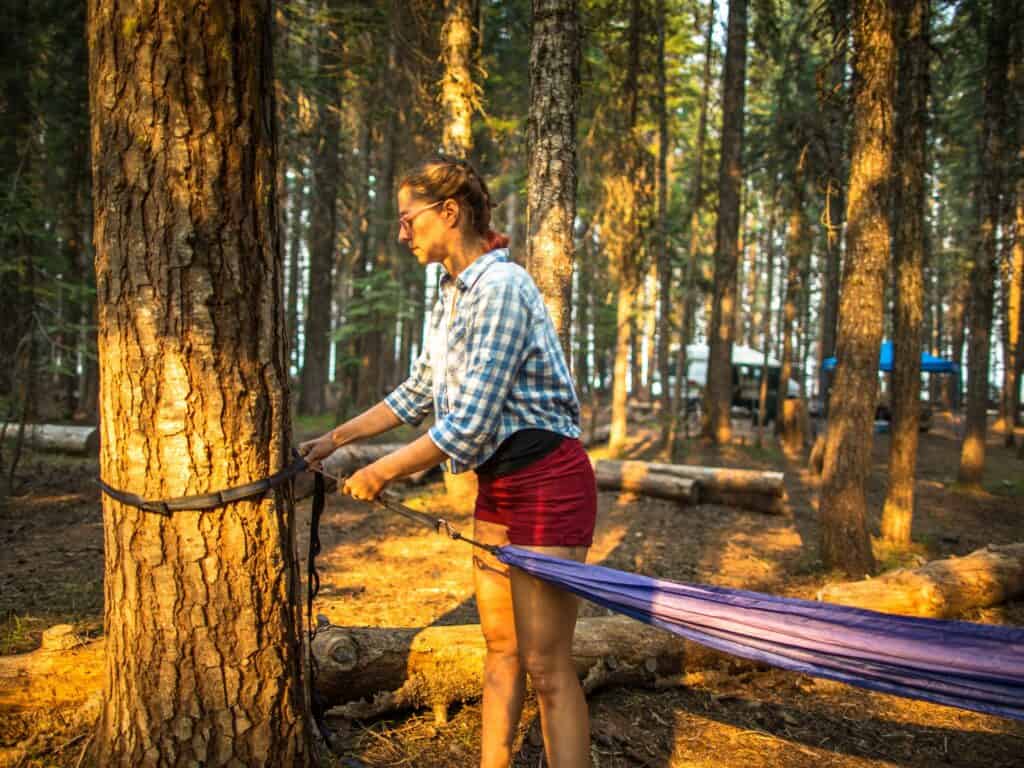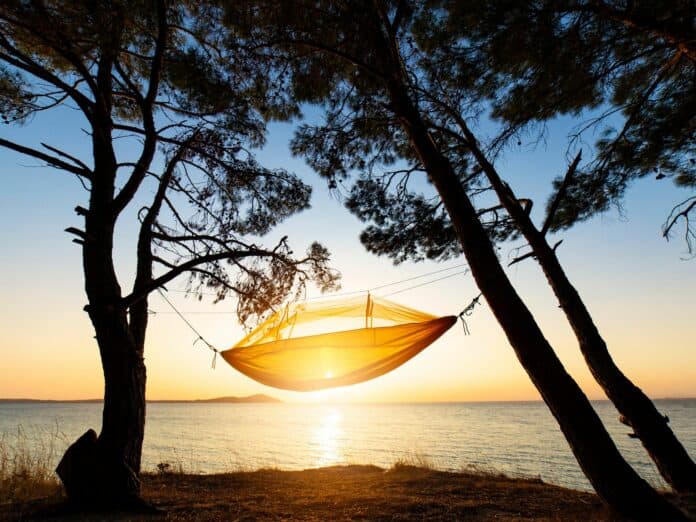Table of Contents
Have you ever dreamed of gently rocking in a hammock as you drift off to sleep under the stars? For camping enthusiasts seeking an ultra-lightweight and flexible sleep system, hammock camping unlocks new possibilities. Avoid the damp, rocky ground and embrace the freedom of hanging your shelter from trees instead!
Hammock camping does require some specialized gear and technique, especially for beginners. Follow this guide to learn the essential hammocking skills and gear you’ll need to sleep comfortably suspended off the ground.
An Introduction to Hammock Camping
Hammock camping utilizes an enclosed hammock as an ultralight sleeping platform on camping trips. A waterproof tarp or rain fly is hung above for weather protection. Mosquito netting, insulation, and other accessories can also be added.
Benefits of hammock camping include:

- Minimized impact on terrain since you’re not sleeping on the ground
- Hammocks help follow Leave No Trace principles because they don’t flatten vegetation or degrade topsoil like tent camping does. Suspending your shelter prevents damage to sensitive natural areas.
- Comfortable sleeping position and ergonomic support for your back
- Hammocks contour to your body’s natural curves, reducing pressure points. Sleeping at a slight diagonal angle provides optimal back alignment and spinal support. This can help reduce back pain that often results from sleeping on the hard ground.
- Flexibility in pitching your “tent” anywhere there are trees
- Unlike tent camping which requires flat, obstruction-free tent sites, hammocks can be set up in small forest clearings, between boulders, over uneven ground, etc. All you need are two properly spaced anchor points like trees. This greatly expands your options for stealth campsites.
- Stay above wet, cold, or rocky ground
- Get up off the damp earth and avoid rocks, roots and critters on the ground. Hammocks keep you dry in wet conditions and warmer by not losing heat to the ground. No more waking up with a sore back or wet sleeping bag!
The main types of hammocks used for camping are:
- Parachute nylon hammocks – lightweight and breathable
Parachute nylon is a popular hammock material because it packs down small and has excellent breathability. The thin fabric conforms well to your body. Parachute nylon hammocks often weigh under 2 lbs, making them ultralight. However, they are less durable over time.
- Cuben fiber hammocks – waterproof and super compact
Cuben fiber is an ultra-strong, waterproof composite material used for the most lightweight hammocks. Only weighing 16-22 oz, cuben hammocks compress down tiny. This comes at a premium price point. Cuben lacks breathability but provides weather protection.
- Expedition hammocks – durable and max capacity for gear storage
Built with heavy ripstop nylon or canvas, these durable hammocks hold more weight and gear. They have integrated shelves, pockets and loops for attaching accessories. While bulky and heavier, expedition hammocks stand up to years of frequent use in harsh conditions.
Compared to tent camping, the main trade-off is less privacy and protection from elements. But hammocks make up for this in portability and comfort.
Choosing the Right Hammock Setup
Focus on size, weight, and features when selecting a camping hammock.
For size, make sure you can lie diagonally inside with optimal ergonomic sag. Popular sizes are 9-12 feet long.
Ultralight Cuban fiber and premium nylon hammocks minimize pack weight. Entry-level options often weigh over 2 pounds.
Look for useful features like storage shelves and pockets. An asymmetric style hangs straighter for better sleep.
A matching tarp and bug net are essential accessories. A detachable, waterproof tarp above provides rain and splash protection. An integrated no-see-um mesh net keeps mosquitos away.
Best Practices for Comfy Hammock Sleeping
Insulation and padding are key for staying warm and cozy in your hammock:
- An insulated sleeping pad prevents cold from below and cushions ya. Inflatable pads work best.
- Sleeping bags with pad sleeves let you attach it securely. Underquilts made for hammocks also insulate the bottom.
- Tying out the tarp ridgeline makes a “vestibule” to stow gear under and avoid splash back rain.
- Stay dry by wiping feet before climbing in, using a moisture-wicking sleep bag, and keeping damp stuff away from the hammock.
Finding the Perfect Hammock Campsite
When setting up your hang, keep these ideal conditions in mind:
- Trees about 16-20 feet apart allow a nice flat lay. Anchor points should be at least 12 inches wide.
- 30-60 degree angles between the anchors give great ergonomic comfort.
- Grass or dirt is hammock-friendly. Steer clear of rocks and roots underfoot.
- Follow Leave No Trace – use wide straps to protect tree bark. Pick durable anchor points.
If there aren’t trees, bring backup supports like stands. Scout for open sites with level ground.
Hanging and Securing Your Hammock

Use these tips for solid hangs:
- Put tree straps at least 12 feet high around trunks using loops or daisy chains. Avoid rope that could hurt the bark.
- A Marlinspike hitch securely clips hammock carabiners to straps. Or you can try a Becket hitch.
- Lay diagonally with 30° sag comfy zones on both sides. Attach bug net and rain fly.
- Use guy lines, stakes, and ridge tensioners to keep the rain fly tight.
- Adjust the jump seat, storage shelves etc. to suit your needs.
Staying Warm and Dry in Your Hammock
Hammocks can get pretty chilly without insulation underneath ya. Here are some useful tips:
- An underquilt or sleeping pad sleeves are crucial for keeping heat in your hammock cocoon.
- Change outta any wet clothes before bed to avoid moisture buildup inside.
- Cocoon yourself in a warm sleeping bag suited for the coldest temps expected.
- In extreme cold, toss a hot water bottle or disposable hand warmers inside.
- Manage condensation by positioning your rain fly with plenty of ventilation room.
Hammock Camping Luxuries
While ultralight gear is great for hiking, don’t skimp on creature comforts!
- A pillow, foam seat pad, and camp chair take relaxation to the next level.
- Battery-powered lanterns and string lights set a fun mood.
- Bluetooth speakers and electronics like phones or iPads allow entertainment.
- Multi-use tables and pull-out kitchens offer dining and prep space.
- An EcoFlow RIVER 2 Pro portable power station lets you run string lights, speakers, and tablets for hours without another power source. Its advanced batteries can harness the power of the sun, recharging completely in as little as 70 minutes of solar exposure. With over 3000 charge cycles, it will keep your essentials powered trip after trip.
Hammock Camping Safety Tips
Be sure to prioritize safety with these precautions:
- Test the weight capacity before fully counting on your hammock system.
- Sleep with your feet toward the anchors in case of sudden failure or collapse.
